Chain Reaction
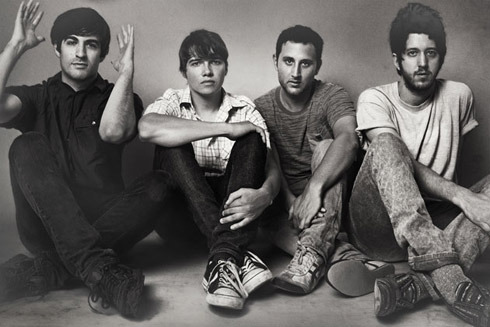
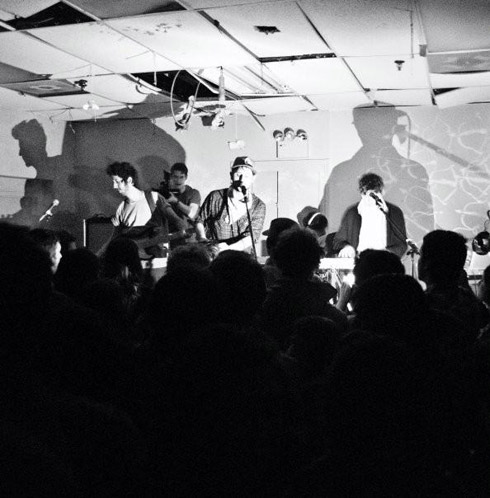
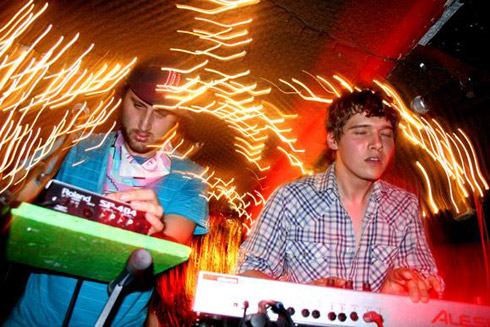
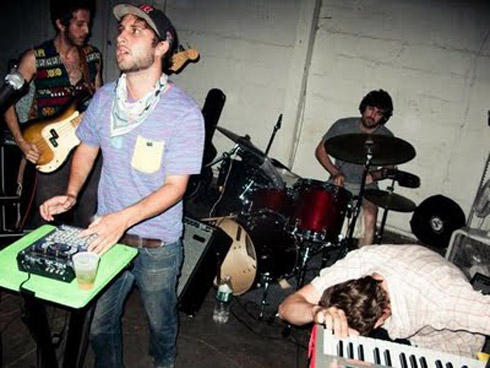
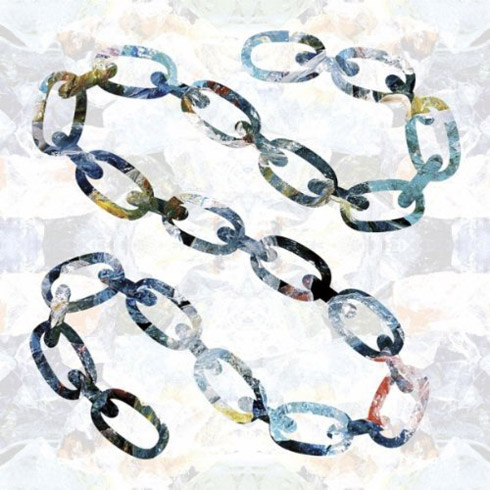 Text: Digby Woods Images: Small Black
Text: Digby Woods Images: Small Black
Brooklyn-based foursome, Small Black, are the personification of feel-good electro-pop. Listening to any one of their songs, you get a feel for the mile-long back catalogue of artists they draw inspiration from, each one as appreciated and loved as the next, from Prince to New Order, Talk-Talk to Mobb Deep, as well as contemporary artists like Julian Lynch, Oneohtrix Point Never and John Maus. You might think that such a mountain of influence would overwhelm their music, that there might be the tendency to over-indulge. Thankfully, Small Black manage to keep things in balanced, like a fat kid standing in the middle of a see-saw.
Since releasing their debut EP in 2009, Small Black have managed to penetrate the US music-blogosphere quite deeply and hence gain national recognition for their styled-out blend of neo-new-wave electro-pop. Now, two years later, we see the release of their debut LP, New Chain, a record that’s guaranteed to push that recognition worldwide.
Digby Woods managed to track down Small Black bassist, Juan Pieczanski, to talk music videos, the influence of the Badlands movie, embarrassing past music tastes, and the importance of experimentation.
Digby Woods: Stylistically, your music reveals a diverse range of influences, from Wu-Tang to Neil Young. In the short time you’ve been around, how has your music evolved, from before the EP through to after your debut full-length?
Juan Pieczanski: Before Small Black existed, we were all making various records, mainly guitar and live drum-based stuff. The EP was a big change from that, it was all keyboards and drum machines. Ultimately we try to make pop songs, so that hasn’t really changed through the EP and LP. On the LP we tried some new production techniques and expanded our synth tones a lot. We were able to make some more lush and layered songs. We also worked on getting more low-end into our mixes, something that would also play well live at clubs.
DW: The music video for Despicable Dogs (directed by Yoonha Park) seems to be of a very personal, almost intimate nature. The man in the video, is that Josh (Kolenik)’s uncle, whose house you recorded the EP at? He seems like an awesome dude. How do such visuals relate to the song itself, what is the connection?
JP: The guy in the video is the band’s honorary uncle–and Josh’s real-life uncle, Matt. He’s an awesome dude, an amazing athlete and surfer/surfboard maker. The connections between the song and the video are mainly just moods that we tried to match between the visuals and the sections of the song. The colours, the sort of everyday life aspect to the video, and just the character of Matt, all of that felt good when we started seeing it over the music. I think a lot of what makes music videos work comes at the moment of truth when you start to actually see the footage over the song. A lot of accidents end up matching up really well and some things you planned don’t fit. We’re really happy with what Yoonha did with the video.
DW: Similarly, let’s talk about the video for Bad Lover. Obviously esotericism, and how an individual interprets said esotericism, are foundational tenets in any art, especially music, but you’re going to have to meet me halfway with this video. How does this video represent Bad Lover?
JP: Haha! Well, Nick Bentgen who directed the video had this really cool compositing technique he was developing, and we all thought the sort of destruction involved fit well with Bad Lover. We also wanted it to be more active, more psychedelic, with more characters. We’re definitely interested in getting more literal in the future, but for now, we’re still experimenting with what kinds of visuals work with our music.
DW: Is seems to be a common characteristic among many synth-pop bands to purposefully keep the lyrics somewhat distorted? Is it a symptom of this particular style of music, much like it was with the proto-shoegaze bands of the ’80s and ’90s?
JP: We think about this a LOT. We’ve tried various degrees of vocal effects, distortions, reverbs, delays, etc. I think in a lot of cases people don’t want to showcase lyrics, but for us it’s a balance we’re looking for. We want the synths and beats to be really present and the lyrics to sit in the mix so that you can understand key words and phrases. As we’ve gotten better at production, we’ve talked more about making the vocals more present, more on top of the mix, because we want to showcase the words more. The challenge is riding that line between dance music, pop, lo-fi and shoegaze, while pushing the vocals upfront. That’s what we’re working on.
DW: The first EP was recorded as a two-some, with Josh (vocals, synth) and Ryan Heyner (vocals, synth). By the time you came to record the debut LP, yourself and Jeff Curtin (drums) had been added to the mix. How did this change in the group dynamic affect the overall production of the record? Was it basically like recording the EP but with two more heads and thus four times as many ideas?
JP: The EP was recorded mainly out in Long Island, and we did some vocal production in my studio in New York. We’ve all been playing in bands together for years, each of us sort of experimenting with different directions, and this Small Black concept just started to hit, so we all gathered our heads together and focused on it. Josh and Ryan also realised that they didn’t want to fall into the laptop-electro-pop-with-backing-tracks scene, so it made sense (since Jeff and I play various instruments) to team up on creating a dynamic live show. We all just play whatever’s necessary to make the songs work, whatever translates live, both sonically and visually. And this is constantly changing as we tour and change the live set.
DW: Songs from your EP like Bad Lover, Weird Machines and Lady In The Wires speak clearly of a shoegaze influence, and while New Chain definitely retains this, everything sounds more polished and undisguised this time around, especially with songs like Photojournalist and Search Party. Did you come at New Chain with a different mindset to the EP? What did you hope to achieve with the former compared to the latter?
JP: We definitely wanted to make the songs a bit less harsh, wider, with more defined low-end, and with clearer vocal production. We see New Chain as a step in the right direction, and I see us getting more minimal in terms of instrumentation as we move forward.
DW: Some of your contemporaries have mentioned the difficulties they’ve had in bringing their songs across to the ‘live’ setting, that they don’t hit as hard in the club as they do on your headphones. Did you have similar troubles when you first started playing live? How did you compensate for this while still retaining your sound?
JP: We’re still always working towards making our live show sound and flow better. It really comes with just playing tons of shows – I think we played 130 sets in the last year. We really had no experience with pulling off this kind of live band/electronics setup, so our early shows were really loud and had more of a punk show vibe.
As we’ve had more experience live, we’ve found ways of keeping some of that punk vibe in our energy while making the tones bigger and punchier. We want it to sound good, we want people to dance, and that takes a lot in terms of sound. Our next move is getting a sound guy to tour with us, someone who really understands how to mix live and electronic elements together.
DW: Listening to your songs and reading articles about you, it’s clear each of you have great taste in music, but everyone has those early days of ignorance, where we grope with shy awkwardness and no clue through the musical landscape. What were some of the earliest records you owned? Anything that you look back on with a cringe?
JP: I’ve listened to tons of embarrassing stuff! Everything from Live to Counting Crows to bad Soundgarden, grunge spin-offs and crappy mainstream rock radio. Early records included Michael Jackson’s Dangerous, a not-embarrasing purchase of Yo La Tengo’s Electropura (I randomly picked it up at a record store) and Live’s Throwing Copper. Hey, that record sold like eight million!
DW: Tell me a little bit about the art direction you take with your music, in regards to cover art, music videos, t-shirts, etc. Where do you draw inspiration from?
JP: We just love our friend Morgan Blair’s art, so we have her do all our covers. She gives us a few options/ideas, and we generally love something right away. For the EP, Josh worked closely with her to create the cover, we were still figuring out what our stuff should look like. With the LP, Ryan had this photo of coloured glass bits that we sent to Morgan. She just made this awesome chain out of it, and we thought it was iconic enough to not have any words on the cover. As far as t-shirts and other design, I put most of that together. We all throw out ideas and I’ll make it on Photoshop. I love that program.
DW: A lot of interviewers attribute a band’s geography as having a significant impact on the music they make. You grew up in Long Island, NY, but do you think the sound of Small Black would be any different if you grew up in Juno, Alaska or Baskerfield, California or Norman, Oklahoma? Is geographic influence really as important as it’s made to seem?
JP: It’s hard to say. Half the band is from New York, and half is from DC. The DC half brings a certain flavor to it, maybe more post-punk/Dismemberment Plan/Fugazi/go-go, and the Long Island half brings the east coast hip-hop vibe, and there is definitely a certain hard to describe emotion that comes from that area.
DW: How did your 7″ split with Washed Out come about? Were you friends with him before you collaborated? How was it touring with him?
JP: We met online just admiring each other’s songs. Before the whole “chillwave” thing even came into existence, we were checking out Washed Out and Neon Indian, really digging what they were doing. It seemed natural to just email Ernest and once we all realized we were on the same page, the remixes came about. We love what he did with Despicable Dogs. He has an amazing ear. The tour was amazing, just as both our bands were getting some buzz. Lots of kids, lots of dancing, lots of partying. That first Small Black/Washed Out tour is tough to beat, just in terms of the exiting new energy we were feeling at the shows. We also played as Washed Out’s band for half of his set, and that was really fun. His stuff is fun, huge sounding, hypnotic stuff to play.
DW: Are there any non-musical influences that have a particular influence on your music?
JP: Hard to say, we all definitely watch a lot of movies and read different kinds of stuff. Josh gets into various different books and movies that influence the lyrics. The movie Badlands was a big influence on some of the early songs.
DW: Are there any new bands that are getting high rotation on your speakers at the moment?
JP: We’re loving Salem, Teengirl Fantasy, Crystal Castles’ new album, James Blake and Class Actress.
DW: What do you see for yourself in 2011?
JP: We’re working on new Small Black material, developing a different direction musically. A lot of testing going on, we’re getting scientific. That and probably lots of touring, remixes and eating.
Small Black
Next story: All In A Leather – Benah



